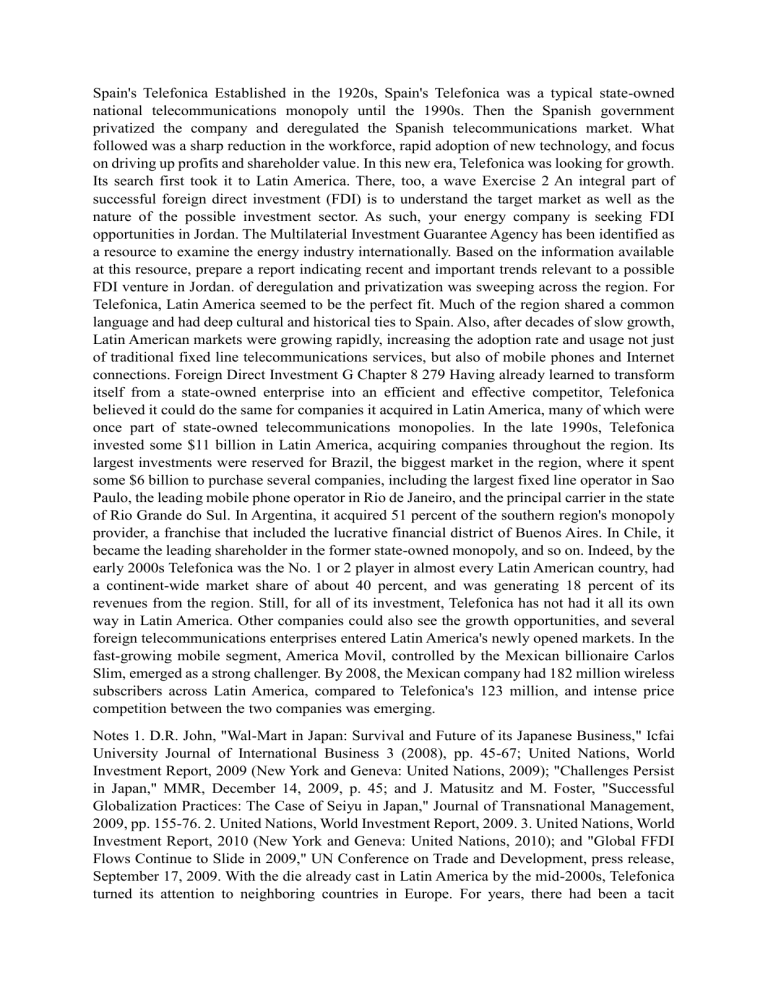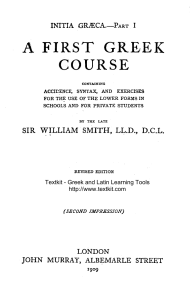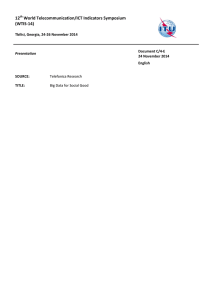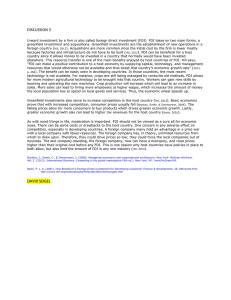
Spain's Telefonica Established in the 1920s, Spain's Telefonica was a typical state-owned national telecommunications monopoly until the 1990s. Then the Spanish government privatized the company and deregulated the Spanish telecommunications market. What followed was a sharp reduction in the workforce, rapid adoption of new technology, and focus on driving up profits and shareholder value. In this new era, Telefonica was looking for growth. Its search first took it to Latin America. There, too, a wave Exercise 2 An integral part of successful foreign direct investment (FDI) is to understand the target market as well as the nature of the possible investment sector. As such, your energy company is seeking FDI opportunities in Jordan. The Multilaterial Investment Guarantee Agency has been identified as a resource to examine the energy industry internationally. Based on the information available at this resource, prepare a report indicating recent and important trends relevant to a possible FDI venture in Jordan. of deregulation and privatization was sweeping across the region. For Telefonica, Latin America seemed to be the perfect fit. Much of the region shared a common language and had deep cultural and historical ties to Spain. Also, after decades of slow growth, Latin American markets were growing rapidly, increasing the adoption rate and usage not just of traditional fixed line telecommunications services, but also of mobile phones and Internet connections. Foreign Direct Investment G Chapter 8 279 Having already learned to transform itself from a state-owned enterprise into an efficient and effective competitor, Telefonica believed it could do the same for companies it acquired in Latin America, many of which were once part of state-owned telecommunications monopolies. In the late 1990s, Telefonica invested some $11 billion in Latin America, acquiring companies throughout the region. Its largest investments were reserved for Brazil, the biggest market in the region, where it spent some $6 billion to purchase several companies, including the largest fixed line operator in Sao Paulo, the leading mobile phone operator in Rio de Janeiro, and the principal carrier in the state of Rio Grande do Sul. In Argentina, it acquired 51 percent of the southern region's monopoly provider, a franchise that included the lucrative financial district of Buenos Aires. In Chile, it became the leading shareholder in the former state-owned monopoly, and so on. Indeed, by the early 2000s Telefonica was the No. 1 or 2 player in almost every Latin American country, had a continent-wide market share of about 40 percent, and was generating 18 percent of its revenues from the region. Still, for all of its investment, Telefonica has not had it all its own way in Latin America. Other companies could also see the growth opportunities, and several foreign telecommunications enterprises entered Latin America's newly opened markets. In the fast-growing mobile segment, America Movil, controlled by the Mexican billionaire Carlos Slim, emerged as a strong challenger. By 2008, the Mexican company had 182 million wireless subscribers across Latin America, compared to Telefonica's 123 million, and intense price competition between the two companies was emerging. Notes 1. D.R. John, "Wal-Mart in Japan: Survival and Future of its Japanese Business," Icfai University Journal of International Business 3 (2008), pp. 45-67; United Nations, World Investment Report, 2009 (New York and Geneva: United Nations, 2009); "Challenges Persist in Japan," MMR, December 14, 2009, p. 45; and J. Matusitz and M. Foster, "Successful Globalization Practices: The Case of Seiyu in Japan," Journal of Transnational Management, 2009, pp. 155-76. 2. United Nations, World Investment Report, 2009. 3. United Nations, World Investment Report, 2010 (New York and Geneva: United Nations, 2010); and "Global FFDI Flows Continue to Slide in 2009," UN Conference on Trade and Development, press release, September 17, 2009. With the die already cast in Latin America by the mid-2000s, Telefonica turned its attention to neighboring countries in Europe. For years, there had been a tacit agreement between national telecommunications companies that they would not invade each other's markets. In 2005 this started to break down when France Telecom entered Spain, purchasing Amena, the country's second-largest mobile carrier behind Telefonica. Telefonica moved quickly to make its own European acquisition, acquiring Britain's major mobile phone operator, 02, for $31.4 billion. 02 already had significant operations in Germany as well as the United Kingdom. The acquisition transformed Telefonica into the second-largest mobile phone operator in the world, measured by customers, behind China Mobile. Questions 1. What changes in the political and economic environment allowed Telefonica to start expanding globally? 2. Why did Telefonica initially focus on Latin America? Why was it slower to expand in Europe, even though Spain is a member of the European Union? 3. Telefonica has used acquisitions, rather than greenfield ventures, as its entry strategy. Why do you think this has been the case? What are the potential risks associated with this entry strategy? 4. What is the value that Telefonica brings to the companies it acquires? 5. In your judgment, does inward investment by Telefonica benefit a host nation? Explain your reasoning?




